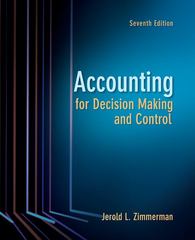Question
Assume that a Parent company acquires a 60% interest in its Subsidiary on January 1, 2020.On the date of acquisition, the fair value of the
Assume that a Parent company acquires a 60% interest in its Subsidiary on January 1, 2020.On the date of acquisition, the fair value of the 60% controlling interest was $1,440,000 and the fair value of the 40% noncontrolling interest was $960,000.On January 1, 2020, the book value of net assets equaled $2,400,000 and the fair value of the identifiable net assets equaled the book value of identifiable net assets (i.e. there was no AAP or Goodwill). The parent uses the equity method to account for its investment in the subsidiary.
On December 31, 2021, the Subsidiary company issued $3,000,000 (face) 5 percent, five-year bonds to an unaffiliated company for $2,760,436.The bonds pay interest annually on December 31, and the bond discount is amortized using the straight-line method.This results in annual bond-payable discount amortization equal to $47,913 per year.
On December 31, 2023, the Parent paid $3,081,698 to purchase all of the outstanding Subsidiary company bonds.The bond premium is amortized using the straight-line method, which results in annual bond-investment premium amortization equal to $27,233 per year.
The Parent and the Subsidiary report the following financial statements for the year ended December 31, 2024:
Income Statement
Income Statement
Parent Subsidiary
Sales $1,100,000 $800,000
Cost of goods sold -440,000 -450,000
Gross Profit 660,000 350,000
Income (loss) from subsidiary 91,398
Bond interest income 122,767
Bond interest expense -197,913
Operating expenses -230,000 -125,000
Net income $644,165 $27,087
Statement of Retained Earnings
Parent Subsidiary
BOY Retained Earnings $4,000,000 $450,000
Net income 644,165 27,087
Dividends -200,000 -25,000
EOY Retained Earnings $4,444,165 $452,087
Balance Sheet
Parent Subsidiary
Assets:
Cash $1,750,000 $800,000
Accounts receivable 800,000 750,000
Inventory 1,200,000 250,000
Equity Investment 1,289,761
Investment in bonds 3,054,465
PPE, net 12,806,046 6,392,262
$20,900,272 $8,192,262
Liabilities and Stockholders' Equity:
Accounts payable $1,600,000 $838,000
Current Liabilities 2,200,000 1,100,000
Bonds payable 2,904,174
Long-term Liabilities 2,226,100 950,000
Common Stock 1,162,000 398,000
APIC 9,268,007 1,550,000
Retained Earnings 4,444,165 452,087
$20,900,272 $8,192,262
Required:
Provide the consolidation entries and a consolidation worksheet for the year ended December 31, 2022
Step by Step Solution
There are 3 Steps involved in it
Step: 1

Get Instant Access to Expert-Tailored Solutions
See step-by-step solutions with expert insights and AI powered tools for academic success
Step: 2

Step: 3

Ace Your Homework with AI
Get the answers you need in no time with our AI-driven, step-by-step assistance
Get Started


